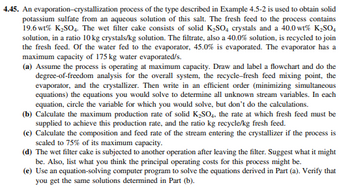
Introduction to Chemical Engineering Thermodynamics
8th Edition
ISBN: 9781259696527
Author: J.M. Smith Termodinamica en ingenieria quimica, Hendrick C Van Ness, Michael Abbott, Mark Swihart
Publisher: McGraw-Hill Education
expand_more
expand_more
format_list_bulleted
Question

Transcribed Image Text:4.45. An evaporation-crystallization process of the type described in Example 4.5-2 is used to obtain solid
potassium sulfate from an aqueous solution of this salt. The fresh feed to the process contains
19.6 wt% K₂SO4. The wet filter cake consists of solid K₂SO4 crystals and a 40.0 wt% K₂SO4
solution, in a ratio 10 kg crystals/kg solution. The filtrate, also a 40.0% solution, is recycled to join
the fresh feed. Of the water fed to the evaporator, 45.0% is evaporated. The evaporator has a
maximum capacity of 175 kg water evaporated/s.
(a) Assume the process is operating at maximum capacity. Draw and label a flowchart and do the
degree-of-freedom analysis for the overall system, the recycle-fresh feed mixing point, the
evaporator, and the crystallizer. Then write in an efficient order (minimizing simultaneous
equations) the equations you would solve to determine all unknown stream variables. In each
equation, circle the variable for which you would solve, but don't do the calculations.
(b) Calculate the maximum production rate of solid K₂SO4, the rate at which fresh feed must be
supplied to achieve this production rate, and the ratio kg recycle/kg fresh feed.
(c) Calculate the composition and feed rate of the stream entering the crystallizer if the process is
scaled to 75% of its maximum capacity.
(d) The wet filter cake is subjected to another operation after leaving the filter. Suggest what it might
be. Also, list what you think the principal operating costs for this process might be.
(e) Use an equation-solving computer program to solve the equations derived in Part (a). Verify that
you get the same solutions determined in Part (b).
Expert Solution
This question has been solved!
Explore an expertly crafted, step-by-step solution for a thorough understanding of key concepts.
This is a popular solution
Trending nowThis is a popular solution!
Step by stepSolved in 5 steps with 5 images

Knowledge Booster
Similar questions
- What is meant by loading in adsorption?arrow_forwardIn distillation, what is meant by reflux, boilup, rectification section, and stripping section?arrow_forwardDesribe the general composition, properties, uses, applications of the following materials and their reasons: HSLA steel Gray cast ironarrow_forward
arrow_back_ios
arrow_forward_ios
Recommended textbooks for you
 Introduction to Chemical Engineering Thermodynami...Chemical EngineeringISBN:9781259696527Author:J.M. Smith Termodinamica en ingenieria quimica, Hendrick C Van Ness, Michael Abbott, Mark SwihartPublisher:McGraw-Hill Education
Introduction to Chemical Engineering Thermodynami...Chemical EngineeringISBN:9781259696527Author:J.M. Smith Termodinamica en ingenieria quimica, Hendrick C Van Ness, Michael Abbott, Mark SwihartPublisher:McGraw-Hill Education Elementary Principles of Chemical Processes, Bind...Chemical EngineeringISBN:9781118431221Author:Richard M. Felder, Ronald W. Rousseau, Lisa G. BullardPublisher:WILEY
Elementary Principles of Chemical Processes, Bind...Chemical EngineeringISBN:9781118431221Author:Richard M. Felder, Ronald W. Rousseau, Lisa G. BullardPublisher:WILEY Elements of Chemical Reaction Engineering (5th Ed...Chemical EngineeringISBN:9780133887518Author:H. Scott FoglerPublisher:Prentice Hall
Elements of Chemical Reaction Engineering (5th Ed...Chemical EngineeringISBN:9780133887518Author:H. Scott FoglerPublisher:Prentice Hall
 Industrial Plastics: Theory and ApplicationsChemical EngineeringISBN:9781285061238Author:Lokensgard, ErikPublisher:Delmar Cengage Learning
Industrial Plastics: Theory and ApplicationsChemical EngineeringISBN:9781285061238Author:Lokensgard, ErikPublisher:Delmar Cengage Learning Unit Operations of Chemical EngineeringChemical EngineeringISBN:9780072848236Author:Warren McCabe, Julian C. Smith, Peter HarriottPublisher:McGraw-Hill Companies, The
Unit Operations of Chemical EngineeringChemical EngineeringISBN:9780072848236Author:Warren McCabe, Julian C. Smith, Peter HarriottPublisher:McGraw-Hill Companies, The

Introduction to Chemical Engineering Thermodynami...
Chemical Engineering
ISBN:9781259696527
Author:J.M. Smith Termodinamica en ingenieria quimica, Hendrick C Van Ness, Michael Abbott, Mark Swihart
Publisher:McGraw-Hill Education

Elementary Principles of Chemical Processes, Bind...
Chemical Engineering
ISBN:9781118431221
Author:Richard M. Felder, Ronald W. Rousseau, Lisa G. Bullard
Publisher:WILEY

Elements of Chemical Reaction Engineering (5th Ed...
Chemical Engineering
ISBN:9780133887518
Author:H. Scott Fogler
Publisher:Prentice Hall


Industrial Plastics: Theory and Applications
Chemical Engineering
ISBN:9781285061238
Author:Lokensgard, Erik
Publisher:Delmar Cengage Learning

Unit Operations of Chemical Engineering
Chemical Engineering
ISBN:9780072848236
Author:Warren McCabe, Julian C. Smith, Peter Harriott
Publisher:McGraw-Hill Companies, The